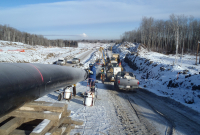On grocery store shelves in Iqaluit, Nunavut, it is hard to find enough lettuce for a family-sized salad for less than 10 bucks. In more remote parts of the northern territory, basic items like an eight-pack of juice — or a handful of fresh veggies — can go for nearly $40.
While inconceivable for most Canadians, these prices are the norm in Nunavut and most of northern Canada.
"Everything is about four times more expensive here," said Muhammad Wani, vice-president of the Islamic Society of Nunavut and head of the organization's Arctic Food Bank. "If you purchase, say, $35 worth of groceries down south … here it will be, say, $100."
Brought in by boat or plane by a handful of grocers, the region has been dealing with high prices and soaring food insecurity for years, despite an annual federal subsidy worth roughly $134 million last year known as Nutrition North.
The northern prices are an extreme example of the global food price crisis, which has gripped the world since inflation rates soared last year. In southern Canada, these months of high prices came as grocers reported record profits, prompting MPs to summon representatives from Canada's three largest grocers to Ottawa in March. The trio was asked to justify why their ledgers showed profits as millions of Canadians struggled to afford food.
Yet as scrutiny swirls around the southern grocers, some northern residents point out they've been dealing with similar issues around costs, transparency and corporate control for years.
"There's been a cost-of-living crisis here in northern Canada, particularly in Indigenous communities, for quite some time," said federal NDP MP Niki Ashton, who represents northern Manitoba, an area also prone to high food prices. "So-called solutions, like the Nutrition North program, are not solutions and are certainly not the permanent solutions to the kind of food insecurity and high cost of living northern communities face."
Between a fifth and half of northern residents are food insecure, particularly in Nunavut, according to federal data. Indigenous people are particularly at risk — the result of colonialism, the isolation of their communities and economic precarity.
According to federal data, in 2019, the average family of four needed to spend roughly $1,680 on food each month. In contrast, researchers estimate the same family in southern Canada in 2019 would only spend a bit over $1,000 each month on food. The federal northern food price estimates have not been updated since inflation soared in 2021.
The Nutrition North program is the federal government's main tool to tackle the issue. Created in 2011, it provides northern grocers — there are only a handful — with a subsidy to reduce transportation costs for dozens of basic goods, like fresh vegetables or milk.
The program also recently included a grant to help hunters catch wild country food, which accounts for roughly a fifth of many northerners' diets, according to Food Secure Canada co-executive director Wade Thorhaug.
Critics have for years attacked the program. In 2014, an auditor general report found the government had "not done the work necessary to verify that northern retailers were passing on the full subsidy to consumers."
In response to the findings, the government implemented new measures in its compliance reviews for retailers to ensure the money gets to the people who need it. These regular reviews are conducted by an independent auditor and assess a sample of the grocers receiving the subsidy. However, a quick scan of these reports notes that in many cases, the auditors could not obtain accurate information about a business's profit margins.
Researchers have also criticized the program for failing to tackle food insecurity. A 2019 study found food insecurity has actually increased since the program was introduced. The findings all point towards what Ashton said is one of the program's biggest flaws: "Nutrition North is a subsidy to corporations rather than the consumer."
In an echo of the situation further south, where three grocers — Loblaws Ltd., Empire and Metro Inc. — control most of the market, both Ashton and Thorhaug said the bulk of the food subsidized by Nutrition North flows through a single company. The Winnipeg-based North West Company's stores are ubiquitous across northern Canada and in many smaller communities; they are one of two — or the only — options, Ashton said.
Like their southern counterparts, the company's dominance over the region's high food prices makes them a lightning rod for criticism. That long-standing resentment has grown in recent years, as the company reported an 82.5 per cent increase in net earnings between 2019 and 2021.
Still, food advocates say the Nutrition North program deserves most of the blame. Pitched by the federal government as a key part of its plan to tackle northern food insecurity, the program in practice does little to ensure northerners — including those with low incomes — can actually afford food.
"Nutrition North needs to be reviewed and transformed in light of the cost-of-living crisis that all of Canada, and particularly northern and Indigenous communities, are facing," Ashton said. The changes should include focusing on ensuring people have enough money to purchase food, including by boosting opportunities for well-paying jobs, and can easily get out on the land to hunt, she added.
Those recommendations were highlighted in a 2021 report by Inuit Tapiriit Kanatami, an organization representing Inuit in Canada. The document, which provides a blueprint to tackle food insecurity in Inuit Nunangat (Inuit regions), also calls for better support for northern airlines and creating better harbours and other infrastructure to support local fisheries or hunters.
Supporting that kind of local production is key, executive director of Iqaluit's Qajuqturvik Community Food Centre Rachel Blais said. In addition to making the region more self-sufficient and resilient, hunting, fishing and other types of local food production are culturally vital. Supporting these practices is foundational to building the region's food sovereignty.
"(Nutrition North) continues to push a reliance on southern food producers and retailers, rather than supporting the existing local food system," she said.






Comments
Hmmm.
Runaway costs due to No farmland, Shipping distance thousands of km, Fridges powered by diesel also shipped thousands of km.
With dozens of times the long-term sustainable population, if the Inuit go back to subsistence hunting all prey will be quickly eradicated.
We grew nice potatoes in our Yellowknife yard, but that was hardly a solution for all 20,000 residents, who have excellent year-round road access; and theoretically even rail as an option.
So it looks like the North is a good predictor of the planetary crises of population, petroleum and food supply.
We would all like to see a solution but some conundrums do not have a solution.
We live in interesting times.
Perhaps the idea that we can live anywhere.........in large and growing numbers......and simply import our food and energy needs, is likely an idea that needs five planets to sustain it. However, it is an idea that we in the privileged west have long toyed with.
Food security for too many of us, means importing other people's harvests, at a cost low enough for us to waste the 40% of food that current studies accuse us of throwing down the black hole of our culture. That we also believed that cities can sprout in our extreme north and live first world lives off what gets trucked in....and out....may well be one form of the hubris coming for many of our 'best laid plans'.
How to create Northern Food security is a very good question and extreme challenge.
But in the meantime, our Federal Government could stop subsidizing the monopoly grocery company....and consider putting more disposable income into the pockets of consumers....Corporate Welfare brings security of any kind...........to a very very small %-age of the population. And that fraction is never food insecure.
There are about 130,000 people in Nunavut, Yukon and NWT, and Nutrition North provides $134 million, or about $1,000 per person to supposedly decrease the price of food imported from the South. When I visited Nain, Labrador, I saw lots of junk food on the grocery shelves as well as stale greens. I suspect it is the same in other northern hamlets and towns.
Caribou is no longer plentiful and arctic char or seal neither. More hunting is not the solution to food insecurity. However, with $1,000 per person, a town could buy one or more self-contained greenhouse containers such as developed by University of Ottawa or other, and produce a good amount of fresh vegetables year-round, independent of the unreliable air or sea shipping. Electricity could come from the local diesel-powered generator, but preferably from solar/wind generators. A few good jobs would be created, technically oriented, creating pride.
As the proverb says, "don't give a fish, show how to fish"
It's funny. When I read the bit about how the prices were ridiculously high (which I knew) and then that there was a program subsidizing the grocers, my absolute first reaction was "Well, the stores are just going to pocket that, right?" I mean duh.
So why is it that career civil servants and politicians with presumed expertise need years and auditor general reports to start considering admitting it? Either they're massive idiots with ideological blinders THIS BIG on, or the explanation starts with "cor" and ends in "uption". Or both.
So, how about nationalizing that grocery company and then hand it over to the First Nations themselves to run as a quasi-co-op.